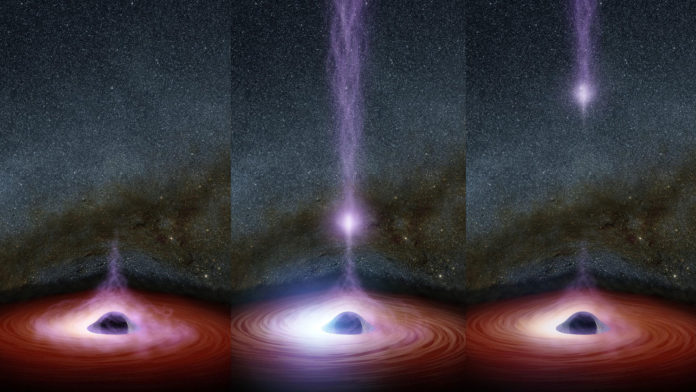For the first time, astronomers at MIT and somewhere else have looked as a supermassive black hole’s corona, the ultrabright, billion-degree ring of high-energy particles that circles a black hole’s event horizon, was abruptly destroyed.
The cause behind this dramatic transformation remains obscure, yet scientists think that the source of the calamity may have been a star caught in the black hole’s gravitational pull.
Like a pebble tossed into a gearbox, the star may have ricocheted through the black hole’s disk of swirling material, causing everything in the vicinity, including the corona’s high-energy particles, to plummet into the black hole suddenly.
The result, as the astronomers observed, was a steep and surprising drop in the black hole’s brightness, by a factor of 10,000, in under just one year.
Erin Kara, assistant professor of physics at MIT, said, “We expect that luminosity changes this big should vary on timescales of many thousands to millions of years. But in this object, we saw it change by 10,000 over a year, and it even changed by a factor of 100 in eight hours, which is just totally unheard of and mind-boggling.”
Following the corona’s vanishing, astronomers kept on looking as the black hole started to gradually pull together the material from its external edges to change its swirling accretion disk, which thus started to spin up high-energy X-rays near the black hole’s event horizon. Along these lines, in only a couple of months, the black hole had the option to create new corona, practically back to its unique glow.
Physicists are not sure exactly what causes a corona to form, but they believe that it has something to do with the configuration of magnetic field lines that run through a black hole’s accretion disk.
At the outer regions of a black hole’s swirling disk of material, magnetic field lines are more or less in a straightforward configuration. Closer in, and especially near the event horizon, material circles with more energy, in a way that may cause magnetic field lines to twist and break, then reconnect. This tangle of magnetic energy could spin up particles swirling close to the black hole, to the level of high-energy X-rays, forming the crown-like corona that encircles the black hole.
According to physicists, if a wayward star were indeed the culprit in the corona’s disappearance, it would have first been shredded apart by the black hole’s gravitational pull, scattering stellar debris across the accretion disk. This may have caused the temporary flash in brightness that ASSASN captured.
This “tidal disruption,” as astronomers call such a jolting event, would have triggered much of the material in the disk to fall into the black hole suddenly. It also might have thrown the disk’s magnetic field lines out of whack in a way that it could no longer generate and support a high-energy corona.
Kara said, “What that tells us is that, if all the action is happening within that tidal disruption radius, that means the magnetic field configuration that’s supporting the corona must be within that radius. This means that, for any normal corona, the magnetic fields within that radius are what’s responsible for creating a corona.”
Scientists determined that if a star for sure was the reason for the black hole’s missing corona, and if a corona were to form in a supermassive black hole of comparable size, it would do as such inside a span of around four light minutes — a distance that generally means around 75 million kilometers from the black hole’s center.
Kara said, “With the caveat that this event happened from a stellar tidal disruption, this would be some of the strictest constraints we have on where the corona must exist.”
Scientists are continuing to study the system, though less frequently, to see what more this system has in store.
Kara says, “We want to keep an eye on it. It’s still in this unusual high-flux state, and maybe it’ll do something crazy again, so we don’t want to miss that.”
Kara and her co-authors, including lead author Claudio Ricci of Universidad Diego Portales in Santiago, Chile, have published their findings today in Astrophysical Journal Letters. Co-authors from MIT include Ron Remillard and Dheeraj Pasham.
